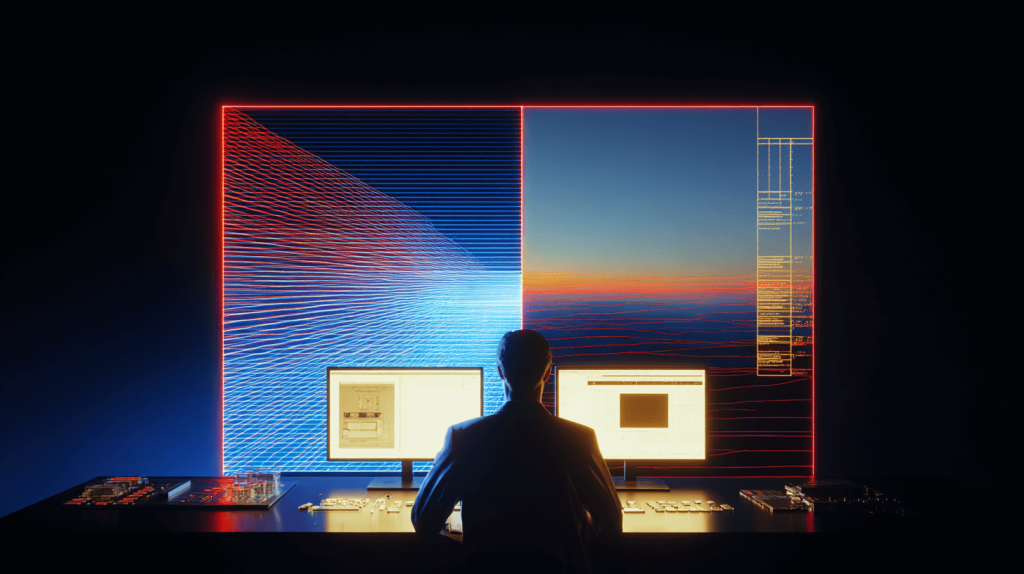Imagine you and your team have spent years working diligently to develop a streamlined technology that provides a technical solution within your industry. You have devoted long nights and weekends to developing a prototype and beta-testing your invention. You probably built a pitch deck and rehearsed your “elevator pitch” hundreds of times in hopes of securing an investment or licensing your technology. Finally, you deploy your technology (that has become your baby) to the public, along with its proprietary features and functionality.
Your technology becomes the go-to solution in the marketplace, and you have ambitions of being acquired or licensed. However, you forgot to take the appropriate steps to protect your technology with a patent, and you start to see your financial scaling pace dwindle, only to discover your competitors have integrated your technology into their products. Suddenly, you realize you are losing your competitive advantage, and your competitors are gaining market traction at your expense. What could you have done to prevent this injustice? by filing a patent application with the United States Patent and Trademark Office (USPTO).
One of the most significant benefits of a patent is the ability to block competitors from copying, manufacturing, selling, or importing into the United States your patented technology without authorization. While this not only provides a significant competitive advantage to you, it also offers legal recourse against infringement and a strong deterrent to competitors.
What is a Patent in Simple Terms?
A patent is a grant from the government to the patent owner (generally, the inventor, applicant, or an assignee who received the rights over the patent) for “the right to exclude others from making, using, offering for sale, or selling” the invention in the United States or “importing” the invention into the United States. It is important to understand that a patent does not give you the right to make or sell a product or service, but rather gives you the right to exclude others from making, using, offering for sale, selling, or importing the subject matter claimed in the patent. Other applicable laws and regulations may also restrict your ability to make or sell a patented product or service.
How to Patent Your Invention?
The starting point is by preparing and filing a patent application with the United States Patent and Trademark Office (USPTO). Patent applications have different sections or parts and generally include drawings (also called figures), a written description of the invention (also called the specification), and one or more claims. Each claim is written as one sentence and may include numerous portions, called claim limitations. Claims state the metes and bounds of the subject matter protected by the patent. Each claim is read separately, and the differences between each claim allow for variations in the description and limits of what the patent protects as your invention.
Benefits of Patent Protection
Patents are a form of intangible assets that provide a variety of competitive advantages for the patent holder, including:
1. The right to exclude others from making, selling, using, offering to sell, or importing into the United States any product that infringes the patent holder’s rights and providing legal remedy should that occur.
2. The right to recover lost profits or reasonable royalties from an infringing party.
3. The ability to monetize the patent through licensing and acquisition.
4. The ability to maintain a competitive advantage over competitors in the marketplace.
What Are the Different Types of Patents?
Provisional Patents
A provisional patent application provides a 12-month window before filing a non-provisional patent application and provides a means to establish an early filing date for your later-filed non-provisional patent application. For companies in the early stages of development, this 12-month pendency time can provide valuable time to develop, beta-test, and finalize your application while being “patent-pending.” A provisional patent provides lower costs than a non-provisional patent application, with fees ranging between $3,500 to $6,000.
Non-Provisional Patent
A non-provisional patent application, often nicknamed “the regular” utility application, if granted, provides 20 years of patent protection from the filing date of your application. Your non-provisional application requires a title, background, summary of the invention, a detailed description, and at least one claim to meet the legal filing requirements for a patent. Most non-provisional patent applications will include 3 independent claims and 20 claims total, although the applicant may purchase additional independent and dependent claims by paying the appropriate fees at the time of electronically filing their application through the USPTO Patent Center.
The fees for a non-provisional patent application range between $6,500 to $25,000, depending on various factors, including the complexity of the invention, prosecution history, and the size of the firm or entity status as defined by the USPTO. You should consider retaining a fixed-fee patent firm to help manage and anticipate your patent prosecution fees and to preemptively alleviate the anxiety caused by billable hours or unknown costs.
Design Patents
Design patents protect the non-functional new, original, and ornamental shape or configuration of an object, the ornamentation on the surface of an object, or decorative aspects of the object. The novelty of your invention is based on the ornamental design and cannot be dictated by the functionality performed by the object.
Plant Patents
A plant patent is a type of utility patent that can be issued for new and asexually reproduced plants. To qualify for a plant patent, the plant must not be a tuber-propagated one (i.e., an Irish potato), it must not be found in an uncultivated condition, and it must be able to be reproduced asexually.
Design Patent vs. Utility Patent
As an inventor, the first question you must ask yourself is, “what is your point of novelty?” Is your point of novelty in the functionality of the invention or the non-functional ornamental design of the invention?
A design patent protects the visual non-functional characteristic of your object or design. Utility patents protect the function or way that an article is used or how it operates. However, both design and utility patent protection may be obtained for certain inventions where the novelty lies in both the ornamental design and functionality of the object.
What Are the Requirements for a Patent?
The Invention Must Be New
To be granted a patent, your invention must not have been previously offered to the public, described in written or published material, or patented anywhere in the world. It is advisable to consult a patent attorney or agent about conducting a prior art search where they will review the embodiments of your disclosure and search through issued patents, published applications, and non-patent literature in your field to determine if your invention is new and novel. This process is known as a “prior art search” or sometimes referred to as a “patentability search.”
The Invention Must Be Non-Obvious
This requirement is entirely subjective and is the most ambiguous to determine. When trying to decide if your invention can be considered non-obvious to “one reasonably skilled in the art,” the U.S. Patent and Trademark Office will consider how easy it would be for a person with ordinary skill in the corresponding field to recreate a similar version of your idea.
The Invention Must Be Useful
The last requirement for patentability is that your invention must be useful. To be considered useful, an invention must perform the function for which it was designed.
It is important to remember that simply being novel and non-obvious alone is not enough to qualify your innovation for a patent. The fundamental rule is that your invention must also serve its intended purpose and have utility. The utility requirement, also known as “usefulness,” is one of the key requirements for a patent and is the most difficult to understand, as what may be considered “useful” for one inventor may be different for another.
The U.S. Patent and Trademark Office has provided guidelines for determining compliance with the utility requirement. According to the standards, the utilities must be:
- Credible: For an invention to be credible, it must either have logical and factual support behind its usefulness or be accepted by someone with skill in the field as currently being useful for the claimed purpose.
- Specific: The utility must be specific to the invention claimed; it cannot be a general utility that could apply to many different inventions.
- Substantial: An invention can only be called substantially useful if it has a clear, defined real-world use. If further research is needed to identify or confirm a use for the invention in the context of the real world, then that utility cannot be considered substantial.
What is Patentable Subject Matter?
The USPTO requires certain criteria for an invention to be eligible for patent protection. An invention can only be considered patent-eligible if it is new, non-obvious, and useful.
Some examples of inventions that may qualify for a patent are:
- Simple or complex machines
- Articles of manufacture.
- Software and computer-related inventions.
- A composition of matter.
- Biotechnology innovations.
What Can’t be Patented?
There are certain types of inventions that are considered non-patentable subject matter and can’t be protected, including:
1. Laws of nature.
2. Abstract ideas.
3. Natural Phenomena.
4. Mathematical concepts, equations, formulae, or calculations.
5. Mental processes such as observing, judging, and evaluating activities within the human mind.
6. Methods of organizing human activity, including certain economic principles.
7. Manner of presenting information or aggregating data.
8. Artistic or literary works.
9. Managing personal behavior, such as social activities, teaching, or rule-based instructions.
Can An Idea Be Patented?
This is often one of the most misunderstood areas of patent law. An idea in the abstract alone, without further conception, is not patentable. As with any invention, it must be novel, non-obvious, and cannot be publicly disclosed for more than one year prior to filing your application. Your invention must then be considered ‘patentable subject matter’ and clearly articulated in your patent application. It is important to remember that not all inventions are patentable subject matter, such as laws of nature, physical phenomena, and abstract ideas.
If your invention does meet statutory requirements for patentability and is considered ‘patentable subject matter,’ here are a few tips to consider when determining how best to develop your idea into a patentable concept:
- Prepare a detailed description: An idea must evolve into a point where the ‘point of novelty’ may be articulated, and the ‘metes and bounds’ of the claimed inventions are clearly described in the application. This means you must provide enough technical details on the features, functionality, and components of your invention that can be described in an invention, along with its best mode of operation.
- Enablement: Your application must be drafted in a manner that one skilled in the field could make and use your invention.
- Utility: Your invention must have a credible and useful utility to address and solve the problem your invention is directed towards.
How to File a Patent Application: Step-by-Step Approach
The first step in preparing your patent application is to draft a thorough disclosure document outlining your invention’s novel features, functionality, and ‘point of novelty,’ including any drawings, diagrams, or flowcharts. With the help of RLG attorneys, we will assist you in describing and defining all of your invention’s novelty, best mode, and enablement. We will work with you to break down your system/method into a series of steps and explain how it both works and solves a real-world problem.
The second step entails thoroughly describing the invention’s ‘point of novelty’ that distinguishes its proprietary features and functionality from other comparable technologies that already exist in the marketplace. Once you have consulted with an RLG attorney on these points of novelty, a prior art search should be conducted to assess the patentability of your invention and how broadly any claims in your application should be drafted.
The third step involves conducting a thorough prior art search. An adequate prior art search saves both time and costs, as it may reveal that existing technology already exists in the public domain or that overlapping existing technologies have already been patented. A detailed prior art search will provide a roadmap for drafting, including the breadth and scope of potential claims.
During the fourth step, your attorney will ensure that your patent application includes 1) claims, 2) specifications, and 3) drawings that highlight the ‘points of novelty’ of your invention.
How Long Does It Take to Get a Patent?
One of the most common questions asked is: how long does it take to get a patent? The USPTO has recently published its most updated patent pendency data, which indicates, on average, that a first office action pendency period is 17.6 months. What this means for an inventor is they should expect their application to remain pending for 17-18 months from the date of filing before receiving their first office action.
Please keep in mind this is the average pendency time for all applications. Historically, based on the complexity and technologies examined, software and computer-implemented inventions may remain pending up to 30 months. Filing your application with a Track One Prioritized Examination Request or a Petition to Make Special can reduce this pendency time by at least one year.
How Can I Speed Up the Patent Process?
For companies and inventors interested in fast-tracking their application, the USPTO offers a Prioritized Patent Examination program, which allows up to 15,000 applications per year to be filed under Track One Prioritized Examination. There are several advantages afforded by this special status, including moving your patent application forward in the examination queue and receiving a final disposition on patentability within twelve months without having to perform a pre-examination search.
Any applicant may ‘request’ Track One Prioritized Examination at the time of filing the application or at the time of filing a Request for Continued Examination, along with the ‘Prioritized Examination Request’ form PTO/AIA/424 and filing fees, which range between $1,000-$3,000 depending on entity status. Though it’s one of the most overlooked programs offered by the USPTO, it’s highly recommended for companies looking to accelerate their prosecution time.
Work With an Experienced Patent Attorney to Get Your Invention Patented
Patents are invaluable assets that will bring your company strategic value. Patents will not only protect your proprietary technology from infringement, increase the valuation of your company, provide a competitive advantage in the marketplace, but will provide both short-term and long-term monetization strategies. The Rapacke Law Group is a fixed-fee (no billable hour) patent and intellectual property firm designed for software and technology companies looking to protect their most valuable intellectual property assets. Our firm provides one transparent fixed fee for all patent and trademark matters without the hassle of surprise costs or nickel-and-dime billing used by traditional law firms.
In addition to a fixed-fee billing approach, RLG offers a money-back guarantee on all prior art searches, trademark applications, provisional patent applications, and design patent applications. To be clear: should our team determine that your invention is not patentable considering the prior art, a full refund will be provided. If patentable, we will credit the cost of your search towards your new application. For the trademark and design patent applications, this means that if your application does not receive a notice of allowance for any reason, we will provide a full refund. Our trademark and design patent application packages include all search, preparation, office action, USPTO correspondence, and filing fees.
Ready to take the next step? Schedule a free IP Strategy call today.
Attorney advertising materials. This article is written for information purposes only and should not be considered as legal advice, nor does this information create an attorney-client or similar relationship. Deciding if you need legal services and choosing a lawyer are important decisions that should be based on criteria beyond these materials. Please contact an experienced, licensed attorney to discuss any specific questions you may have.




